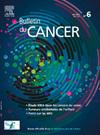Désescalade dans la chirurgie axillaire des cancers du sein : applications en conditions de vie réelle
IF 0.8
4区 医学
Q4 ONCOLOGY
引用次数: 0
Abstract
Les indications de curage axillaire ont été diminuées dans la chirurgie du cancer du sein. Parallèlement, les traitements d’entretien sont complexifiés. Ce paradoxe impose d’évaluer si cette désescalade ne risque pas de sous-estimer l’envahissement ganglionnaire, et d'entraîner une perte de chance pour les patientes éligibles à ces traitements. L’objectif est de déterminer les facteurs d’envahissement ganglionnaire ≥ 4N+ en chirurgie première, de non-réponse histologique ganglionnaire complète en chimiothérapie néoadjuvante, d’évaluer la proportion de patientes ayant une indication de curage axillaire, et la proportion de patientes éligibles à un traitement d’entretien renforcé, en 2023. Il s’agit d’une étude rétrospective monocentrique au Centre Antoine Lacassagne, concernant les patientes traitées pour un cancer du sein avec atteinte ganglionnaire infraclinique entre 2014 et 2020. En chirurgie première, 62,9 %, présentaient un envahissement ganglionnaire < 4N+. Le facteur prédictif d’envahissement ganglionnaire ≥ 4N+ était la perte du caractère ovalaire en échographie (p = 0,01). Après chimiothérapie néoadjuvante, 45,7 % étaient en réponse histologique ganglionnaire complète. L’IRM mammaire et axillaire était l’examen le plus performant pour prédire cette réponse (p = 0,007). Vingt-neuf pour cent des patientes en chirurgie première étaient éligibles au ganglion sentinelle, dont une seule éligible à un traitement d’entretien. Après chimiothérapie néoadjuvante, 46 % auraient pu éviter le curage sans compromettre les traitements d’entretien. Les nouvelles recommandations permettraient d’éviter un curage à 35 % des patientes. En préopératoire, l’échographie est le meilleur examen en chirurgie première. L’IRM est à privilégier pour prédire la réponse à la chimiothérapie néoadjuvante. Il n’existe pas de perte de chance pour les patientes éligibles aux nouveaux traitements adjuvants.
The indications for axillary lymph node dissection (ALND) have been reduced in breast cancer surgery. At the same time, maintenance treatments have become more complex. This paradox makes it essential to assess whether de-escalation might underestimate lymph node invasion, resulting in a loss of chance for patients eligible for these treatments. The aim is to determine the factors for lymph node invasion ≥ 4N+ in primary surgery, and for complete histological lymph node non-response in neoadjuvant chemotherapy, and then to assess the proportion of patients with an indication for ALND, and the proportion of patients eligible for enhanced maintenance treatment, in 2023. This is a single-centre retrospective study conducted at the Centre Antoine Lacassagne, involving patients treated for breast cancer with subclinical lymph node involvement between 2014 and 2020. In primary surgery, 62.9% had lymph node involvement < 4N+. The predictive factor for lymph node involvement ≥ 4N+ was loss of ovality on ultrasound (P = 0.01). After neoadjuvant chemotherapy, 45.7% had a complete histological lymph node response. MRI of the breast and axilla was the best predictor of this response (P = 0.007). Twenty-nine percent of primary surgery patients were eligible for sentinel node therapy, with only one eligible for maintenance treatment. After neoadjuvant chemotherapy, 46% could have avoided ALND without compromising maintenance treatments. Under the new recommendations, 35% of patients could have avoided ALND. Ultrasound is the best preoperative examination for primary surgery. MRI is preferable for predicting response to neoadjuvant chemotherapy. There is no loss of chance for patients eligible for the new adjuvant treatments.
[腋窝乳腺癌手术的降级:现实应用]。
乳腺癌手术中腋窝淋巴结清扫术(ALND)的适应症已经减少。与此同时,保养治疗也变得更加复杂。这一矛盾使得评估降级是否可能低估淋巴结侵袭,从而导致有资格接受这些治疗的患者失去机会变得至关重要。目的是确定原发性手术中淋巴结浸润≥4N+的因素,以及新辅助化疗中完全组织学淋巴结无反应的因素,然后评估2023年有ALND指征的患者比例,以及有资格接受强化维持治疗的患者比例。这是一项在Antoine Lacassagne中心进行的单中心回顾性研究,涉及2014年至2020年间接受亚临床淋巴结累及乳腺癌治疗的患者。在初次手术中,62.9%有淋巴结受累
本文章由计算机程序翻译,如有差异,请以英文原文为准。
求助全文
约1分钟内获得全文
求助全文
来源期刊

Bulletin Du Cancer
医学-肿瘤学
CiteScore
1.90
自引率
16.70%
发文量
224
审稿时长
37 days
期刊介绍:
Without doubt, the ''Bulletin du Cancer'' is the French language publication of reference in the field of cancerology. Official organ of the French Society of Cancer, this journal covers all the information available, whether in the form of original articles or review articles, but also clinical cases and letters to the editor, including various disciplines as onco-hematology, solids tumors, medical oncology, pharmacology, epidemiology, biology as well as fundamental research in cancerology. The journal proposes a clinical and therapeutic approach of high scientific standard and regular updates in knowledge are thus made possible. Articles can be submitted in French or English.
 求助内容:
求助内容: 应助结果提醒方式:
应助结果提醒方式:


